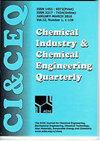使用氧化铁纳米流体的填充吸收柱中二氧化碳减排研究
IF 1
4区 工程技术
Q4 CHEMISTRY, APPLIED
Chemical Industry & Chemical Engineering Quarterly
Pub Date : 2022-01-01
DOI:10.2298/ciceq210510023s
引用次数: 0
摘要
在我们的生态系统中,具有挑战性的任务是在一定程度上减少酸性气体的排放。工业排放许多气体,如H2S、CO、CO2、SO2、NO和NO2作为废气。在这些气体中,CO2、NO2和SO2被称为酸性气体,对人类、动物和植物造成不利影响。由于人为和工业来源的二氧化碳气体排放量增加,因此开展了减缓二氧化碳的研究。采用氧化铁纳米流体和新型结构填充吸收柱对CO2进行了吸附研究。合成了氧化铁纳米颗粒,并用XRD、SEM和TEM对其进行了表征。氨与三种不同浓度(0.0001 w/v%、0.001 w/v%和0.0015 w/v%)的氧化铁纳米流体一起用作吸收剂。结果表明,0.0015 w/v%的氧化铁纳米流体具有较好的CO2去除率。这种提高的% CO2去除效率是由于改善了液相和气相之间的接触,增加了界面面积。在填料塔的同时引入磁场,使CO2去除率提高1.5%。本文章由计算机程序翻译,如有差异,请以英文原文为准。
CO2 mitigation studies in packed absorption column using iron oxide nano fluid
The challenging task in our ecosystem is to reduce acidic gas emissions to some extent. Many gases are emitted from the industries like H2S, CO, CO2, SO2, NO, and NO2 as exhaust gases. Among these gases CO2, NO2 and SO2 are known as acidic gases which result in adverse effects on human beings, animals, and plants. Owing to the increase in the emission of CO2 gases from both anthropogenic and industrial sources, it has resulted in CO2 mitigation studies. CO2 absorption studies have been carried out by employing iron oxide nanofluid with the novel structured packed absorption column. Iron oxide nanoparticles were synthesized and characterized using XRD analysis, SEM analysis, and TEM analysis. Ammonia is used as an absorbent along with iron oxide nanofluid of three different concentrations (0.0001 w/v%, 0.001 w/v%, and 0.0015 w/v%). It was found that the iron oxide nanofluid of 0.0015 w/v% showed an improved % CO2 removal efficiency. This enhanced % CO2 removal efficiency was due to the increased interfacial area of the ameliorated contact between the liquid and gas phase. Along with the packed column the magnetic field was introduced, which resulted in increased % CO2 removal efficiency of 1.5%.
求助全文
通过发布文献求助,成功后即可免费获取论文全文。
去求助
来源期刊

Chemical Industry & Chemical Engineering Quarterly
CHEMISTRY, APPLIED-ENGINEERING, CHEMICAL
CiteScore
2.10
自引率
0.00%
发文量
24
审稿时长
3.3 months
期刊介绍:
The Journal invites contributions to the following two main areas:
• Applied Chemistry dealing with the application of basic chemical sciences to industry
• Chemical Engineering dealing with the chemical and biochemical conversion of raw materials into different products as well as the design and operation of plants and equipment.
The Journal welcomes contributions focused on:
Chemical and Biochemical Engineering [...]
Process Systems Engineering[...]
Environmental Chemical and Process Engineering[...]
Materials Synthesis and Processing[...]
Food and Bioproducts Processing[...]
Process Technology[...]
 求助内容:
求助内容: 应助结果提醒方式:
应助结果提醒方式:


